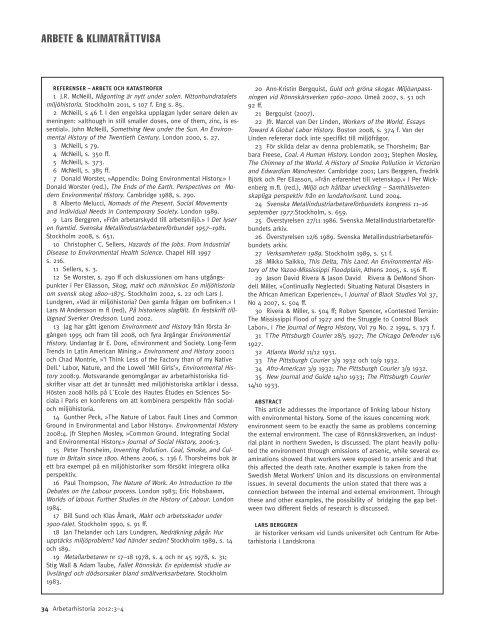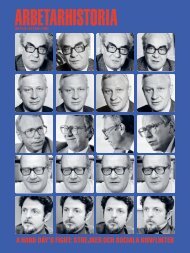Ladda ner (pdf) - Arbetarhistoria
Ladda ner (pdf) - Arbetarhistoria
Ladda ner (pdf) - Arbetarhistoria
You also want an ePaper? Increase the reach of your titles
YUMPU automatically turns print PDFs into web optimized ePapers that Google loves.
ARBETE & KLIMATRÄTTVISA<br />
REFERENSER – ARBETE OCH KATASTROFER<br />
1 J.R. McNeill, Någonting är nytt under solen. Nittonhundratalets<br />
miljöhistoria. Stockholm 2011, s 107 f. Eng s. 85.<br />
2 McNeill, s 46 f. I den engelska upplagan lyder senare delen av<br />
meningen: »although in still smaller doses, one of them, zinc, is essential».<br />
John McNeill, Something New under the Sun. An Environmental<br />
History of the Twentieth Century. London 2000, s. 27.<br />
3 McNeill, s 79.<br />
4 McNeill, s. 350 ff.<br />
5 McNeill, s. 373.<br />
6 McNeill, s. 385 ff.<br />
7 Donald Worster, »Appendix: Doing Environmental History.» I<br />
Donald Worster (red.), The Ends of the Earth. Perspectives on Modern<br />
Environmental History. Cambridge 1988, s. 290.<br />
8 Alberto Melucci, Nomads of the Present. Social Movements<br />
and Individual Needs in Contemporary Society. London 1989.<br />
9 Lars Berggren, »Från arbetarskydd till arbetsmiljö.» I Det lyser<br />
en framtid. Svenska Metallindustriarbetareförbundet 1957–1981.<br />
Stockholm 2008, s. 651.<br />
10 Christopher C. Sellers, Hazards of the Jobs. From Industrial<br />
Disease to Environmental Health Science. Chapel Hill 1997<br />
s. 216.<br />
11 Sellers, s. 3.<br />
12 Se Worster, s. 290 ff och diskussionen om hans utgångspunkter<br />
i Per Eliasson, Skog, makt och människor. En miljöhistoria<br />
om svensk skog 1800–1875. Stockholm 2002, s. 22 och Lars J.<br />
Lundgren, »Vad är miljöhistoria? Den gamla frågan om bofinken.» I<br />
Lars M Andersson m fl (red), På historiens slagfält. En festskrift tilllägnad<br />
Sverker Oredsson. Lund 2002.<br />
13 Jag har gått igenom Environment and History från första årgången<br />
1995 och fram till 2008, och fyra årgångar Environmental<br />
History. Undantag är E. Dore, »Environment and Society. Long-Term<br />
Trends in Latin American Mining.» Environment and History 2000:1<br />
och Chad Montrie, »’I Think Less of the Factory than of my Native<br />
Dell.’ Labor, Nature, and the Lowell ‘Mill Girls’», Environmental History<br />
2008:9. Motsvarande genomgångar av arbetarhistoriska tidskrifter<br />
visar att det är tunnsått med miljöhistoriska artiklar i dessa.<br />
Hösten 2008 hölls på L´Ecole des Hautes Études en Sciences Sociala<br />
i Paris en konferens om att kombi<strong>ner</strong>a perspektiv från socialoch<br />
miljöhistoria.<br />
14 Gunther Peck, »The Nature of Labor. Fault Lines and Common<br />
Ground in Environmental and Labor History». Environmental History<br />
2008:4. Jfr Stephen Mosley, »Common Ground. Integrating Social<br />
and Environmental History.» Journal of Social History, 2006:3.<br />
15 Peter Thorsheim, Inventing Pollution. Coal, Smoke, and Culture<br />
in Britain since 1800. Athens 2006, s. 136 f. Thorsheims bok är<br />
ett bra exempel på en miljöhistoriker som försökt integrera olika<br />
perspektiv.<br />
16 Paul Thompson, The Nature of Work. An Introduction to the<br />
Debates on the Labour process. London 1983; Eric Hobsbawm,<br />
Worlds of labour. Further Studies in the History of Labour. London<br />
1984.<br />
17 Bill Sund och Klas Åmark, Makt och arbetsskador under<br />
1900-talet. Stockholm 1990, s. 91 ff.<br />
18 Jan Thelander och Lars Lundgren, Nedräkning pågår. Hur<br />
upptäcks miljöproblem? Vad händer sedan? Stockholm 1989, s. 14<br />
och 189.<br />
19 Metallarbetaren nr 17–18 1978, s. 4 och nr 45 1978, s. 31;<br />
Stig Wall & Adam Taube, Fallet Rönnskär. En epidemisk studie av<br />
livslängd och dödsorsaker bland smältverksarbetare. Stockholm<br />
1983.<br />
34 <strong>Arbetarhistoria</strong> 2012:3–4<br />
20 Ann-Kristin Bergquist, Guld och gröna skogar. Miljöanpassningen<br />
vid Rönnskärsverken 1960–2000. Umeå 2007, s. 51 och<br />
92 ff.<br />
21 Bergquist (2007).<br />
22 Jfr. Marcel van Der Linden, Workers of the World. Essays<br />
Toward A Global Labor History. Boston 2008, s. 374 f. Van der<br />
Linden refererar dock inte specifikt till miljöfrågor.<br />
23 För skilda delar av denna problematik, se Thorsheim; Barbara<br />
Freese, Coal. A Human History. London 2003; Stephen Mosley,<br />
The Chimney of the World. A History of Smoke Pollution in Victorian<br />
and Edwardian Manchester. Cambridge 2001; Lars Berggren, Fredrik<br />
Björk och Per Eliasson, »Från erfarenhet till vetenskap.» I Per Wickenberg<br />
m.fl. (red.), Miljö och hållbar utveckling – Samhällsvetenskapliga<br />
perspektiv från en lundahorisont. Lund 2004.<br />
24 Svenska Metallindustriarbetareförbundets kongress 11–16<br />
september 1977.Stockholm, s. 659.<br />
25 Överstyrelsen 27/11 1986. Svenska Metallindustriarbetareförbundets<br />
arkiv.<br />
26 Överstyrelsen 12/6 1989. Svenska Metallindustriarbetareförbundets<br />
arkiv.<br />
27 Verksamheten 1989. Stockholm 1989, s. 51 f.<br />
28 Mikko Saikko, This Delta, This Land. An Environmental History<br />
of the Yazoo-Mississippi Floodplain, Athens 2005, s. 156 ff.<br />
29 Jason David Rivera & Jason David Rivera & DeMond Shondell<br />
Miller, »Continually Neglected: Situating Natural Disasters in<br />
the African American Experience», I Journal of Black Studies Vol 37,<br />
No 4 2007, s. 504 ff.<br />
30 Rivera & Miller, s. 504 ff; Robyn Spencer, »Contested Terrain:<br />
The Mississippi Flood of 1927 and the Struggle to Control Black<br />
Labor», i The Journal of Negro History, Vol 79 No. 2 1994, s. 173 f.<br />
31 TThe Pittsburgh Courier 28/5 1927; The Chicago Defender 11/6<br />
1927.<br />
32 Atlanta World 11/12 1931.<br />
33 The Pittsburgh Courier 3/9 1932 och 10/9 1932.<br />
34 Afro-American 3/9 1932; The Pittsburgh Courier 3/9 1932.<br />
35 New Journal and Guide 14/10 1933; The Pittsburgh Courier<br />
14/10 1933.<br />
ABSTRACT<br />
This article addresses the importance of linking labour history<br />
with environmental history. Some of the issues concerning work<br />
environment seem to be exactly the same as problems concerning<br />
the external environment. The case of Rönnskärsverken, an industrial<br />
plant in northern Sweden, is discussed. The plant heavily polluted<br />
the environment through emissions of arsenic, while several examinations<br />
showed that workers were exposed to arsenic and that<br />
this affected the death rate. Another example is taken from the<br />
Swedish Metal Workers’ Union and its discussions on environmental<br />
issues. In several documents the union stated that there was a<br />
connection between the internal and external environment. Through<br />
these and other examples, the possibility of bridging the gap between<br />
two different fields of research is discussed.<br />
LARS BERGGREN<br />
är historiker verksam vid Lunds universitet och Centrum för <strong>Arbetarhistoria</strong><br />
i Landskrona












